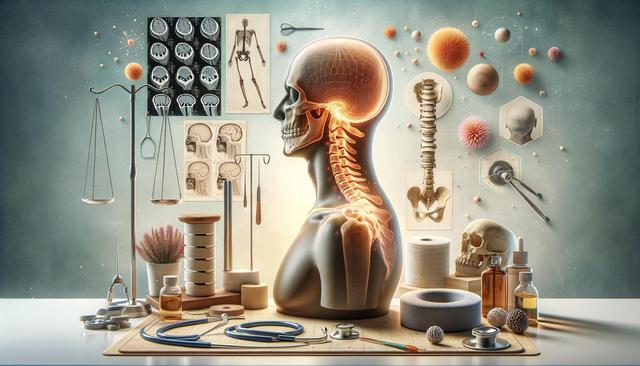What Is Cervical Dizziness?
Cervical dizziness, also known as cervicogenic dizziness, is a condition where individuals experience a sensation of unsteadiness or lightheadedness that originates from the neck. Unlike other forms of vertigo or balance disorders that stem from the inner ear or brain, cervical dizziness typically arises due to structural or functional problems in the cervical spine. Neck-related dizziness may appear after neck trauma, poor posture, or chronic neck pain, and it often worsens with certain head or neck movements.
The underlying mechanism involves disrupted proprioceptive input from the neck to the brain. This input is crucial for spatial awareness and balance. When the muscles, joints, or cervical vertebrae are impaired, the brain may receive conflicting or inaccurate signals, leading to dizziness. This condition is more common in individuals with whiplash injuries, cervical spondylosis, or those who engage in prolonged poor posture activities, such as desk work.
Common symptoms include:
- Lightheadedness or a floating sensation
- Unsteadiness, especially when moving the head
- Neck pain or stiffness
- Headaches
- Visual disturbances or difficulty focusing
Since cervical dizziness shares symptoms with other disorders, accurate diagnosis is key to effective treatment and management.
How Cervical Dizziness Is Diagnosed
Diagnosing cervical dizziness can be complex due to overlapping symptoms with other balance disorders like benign paroxysmal positional vertigo (BPPV) or vestibular migraines. A thorough evaluation is required to differentiate cervical dizziness from these conditions. The diagnostic process usually starts with a detailed medical history and physical examination, focusing on neck mobility, posture, and neurological signs.
Some of the most commonly used diagnostic tools include:
- Clinical testing of neck range of motion
- Balance and gait assessments
- Vestibular function tests to rule out inner ear causes
- Imaging studies such as MRI or CT scans to detect cervical spine abnormalities
- Diagnostic blocks or manual therapy tests to identify cervical structures responsible for symptoms
One hallmark of cervical dizziness is improvement in symptoms following neck treatment or immobilization. If dizziness decreases when the neck is supported or manipulated, it adds weight to the diagnosis of cervicogenic dizziness. Collaboration between neurologists, otolaryngologists, and physical therapists often leads to a more accurate diagnosis.
Physical Therapy and Rehabilitation
Physical therapy is often a central component of treating cervical dizziness. Since the condition is largely mechanical and postural in origin, targeted exercises and manual therapy can significantly reduce symptoms. A skilled physical therapist will assess the patient’s posture, spinal alignment, and muscle function to create a customized treatment plan.
Effective physical therapy approaches may include:
- Range of motion exercises for the neck
- Strengthening exercises for cervical and upper back muscles
- Postural correction techniques
- Vestibular rehabilitation to improve balance
- Manual therapy, including joint mobilization and soft tissue techniques
In addition to in-clinic treatments, home exercise programs are critical for long-term improvement. Patients are typically advised to avoid prolonged forward head posture and incorporate ergonomic changes in their daily routines. Consistency in these practices often leads to reduced frequency and severity of dizziness episodes.
Medication and Medical Interventions
While physical therapy addresses the mechanical aspects of cervical dizziness, medication may be used to manage pain, inflammation, or muscle tension contributing to the condition. However, medication is usually a supportive treatment rather than a standalone solution.
Common medications prescribed include:
- Nonsteroidal anti-inflammatory drugs (NSAIDs)
- Muscle relaxants
- Pain relievers
- Anti-anxiety medications if symptoms are exacerbated by stress
In some cases, more invasive interventions may be considered. Cervical spine injections, such as facet joint blocks or trigger point injections, can provide temporary relief and help identify the source of pain or dizziness. In rare instances where structural abnormalities like herniated discs or severe cervical instability are present, surgical options might be explored. However, these are typically reserved for cases where conservative treatment fails to provide relief.
It’s essential that any medical intervention is supervised by a healthcare professional familiar with cervical spine disorders to avoid complications or misdiagnosis.
Self-Management and Lifestyle Adjustments
In addition to clinical treatments, self-care and lifestyle changes can play a significant role in managing cervical dizziness. Adopting habits that support neck health and reduce strain can help prevent the recurrence of symptoms and improve overall well-being.
Some recommended self-care strategies include:
- Maintaining proper posture, especially during prolonged sitting or screen use
- Taking regular breaks to stretch and move the neck and shoulders
- Using ergonomic chairs and monitor stands to improve workstation alignment
- Applying heat or cold to relieve neck tension
- Practicing mindfulness or relaxation techniques to manage stress-related muscle tension
Staying active through low-impact exercises like walking, swimming, or yoga can also support neck function and reduce the likelihood of dizziness. Patients are encouraged to monitor their symptoms and consult their healthcare provider if new or worsening signs appear. Education and awareness about symptom triggers are key to long-term management.
Conclusion
Cervical dizziness is a multifaceted condition that stems from issues in the neck and can significantly impact daily life. Through a combination of accurate diagnosis, targeted physical therapy, medical interventions, and lifestyle modifications, many individuals find meaningful relief. If you’re experiencing symptoms that suggest cervical dizziness, seeking early evaluation from a qualified healthcare provider can set the stage for effective management and recovery. With a well-rounded approach, it’s possible to regain balance and confidence in everyday activities.


